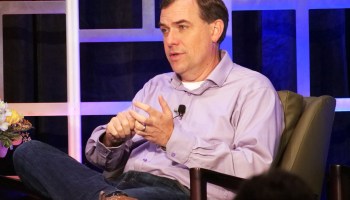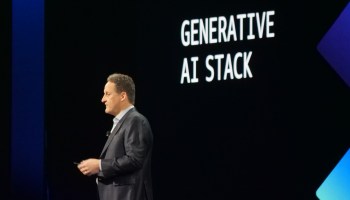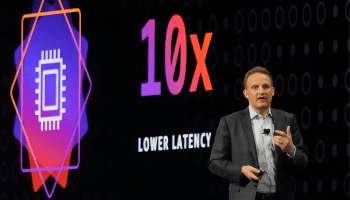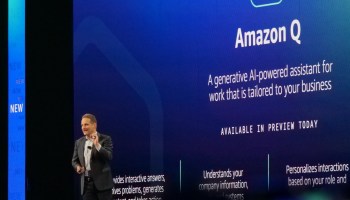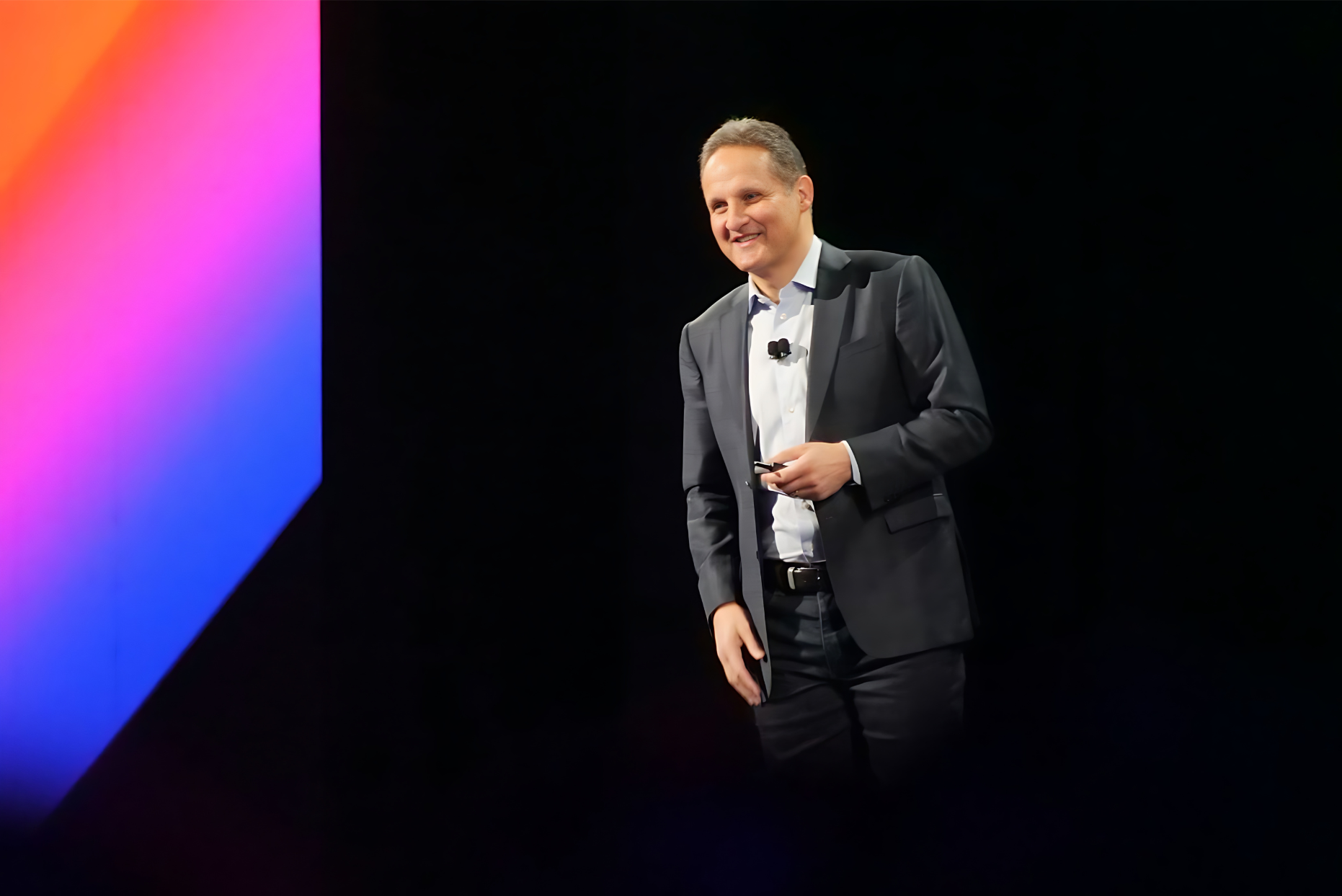
Adam Selipsky spoke with GeekWire this week at Amazon Web Services headquarters in Seattle in an interview prior to his departure as AWS CEO. His final day in the role is today, before handing the reins to longtime AWS exec Matt Garman. Read our overview here, and continue reading for excerpts, edited for context and clarity.
Q: Reading back through your memo to the team about your departure, the phrase that you used was “truly mixed emotions.” Can you walk me through where you are, and your mindset about leaving?
Selipsky: Well, the mixed emotions come from the fact that AWS continues to do as amazing things for customers as it ever has, and that only continues to get more exciting. And also, we have such an amazing team, and of course it’s hard to leave so many folks who are not only world-class in what they do, but are also true and genuine friends. I formed great friendships here, and so that makes it hard.
Coming back to run AWS was an incredible opportunity, and one that I was really excited about, too excited to pass up, and really, it’s been amazing. It’s been a real privilege.
At the same time, I suspected that there would be one more meaningful leadership experience that I would want at some point outside of Amazon, just given the significant number of years that I’ve spent here and my natural curiosity about different experiences. And I’m really energized by all the possibilities of what lies out there ahead for me.
In addition, any good company has a strong succession plan, and AWS had an amazing group of leaders, but they were still going to benefit from some additional experience and mentoring. And part of my mission was to prepare the leadership team, including Matt, whom I hired in 2006 as the very first product manager for AWS, and to prepare them to be ready to take the reins. And that’s part of what Andy [Jassy, Amazon CEO] and I talked about early on.
And then finally, I wanted to ensure that when I did leave, it was at a time when the business was in strong shape, that it had good momentum. The revenue’s grown 85% over the past three years to now over a $100 billion revenue run rate, and that $100 billion would make AWS a Fortune 40 company if we were a standalone business. That’s pretty astounding growth, and I’m really proud of it. And that growth actually accelerated last quarter to 17% year-over-year with really strong profitability.
So if you take all of these things coming together, it made it a good time to activate that succession plan. So I feel really good that I’m handing AWS off in great shape, and I’m really confident in Matt’s abilities and Matt’s readiness to take over. One of the most important jobs of a leader is to prepare the next set of leaders to lead, and that’s what we’ve done.
Q: At the same time, the cloud market has only penetrated the overall IT market by 10 to 15%, and you’re only three steps into a 10K race in AI. [Referencing some of Selipsky’s favorite refrains.] So I can imagine, when you talk about mixed emotions, that’s part of it. There’s huge work ahead for AWS.
Selipsky: The opportunities and the challenges for AWS abound, and I think it is still Day One for the cloud, including AI in that. And I think that there’s going to be incredible innovation. There’s going to be incredible problem-solving for customers, and it’s going to continue to be an amazing time.
For me personally, all those things coming together make this the right time for me to hand over the reins to a group of leaders that I’ve helped prepare, and who I’m confident are ready, while the business is in good shape, and giving me the opportunity to take a step back and give some thought to what I want my next adventure to be.
Q: One of the Amazon leadership principles is to be vocally self-critical. I know you’re a strong adherent to the leadership principles. So if you were to step back objectively and assess your tenure, where do you think you fell short as AWS CEO?
Selipsky: There’s so many facets to this business. I think the pandemic was an incredibly challenging time, on so many dimensions, for so many people. I came into this role during the pandemic, and obviously everybody was working remotely, people in many different working situations. And at the same time, AWS was growing the size of the team at a high rate.
So you had a large number of new people coming in in the middle of this dislocation. Culture is very important at Amazon, our leadership principles are very important, and we take pride in being a little bit peculiar in our culture, and we worked really hard at maintaining that culture during the pandemic, but it was difficult with everybody remote and with so many new people coming in. How do you teach new people Amazon culture remotely?
And I think we did a lot of things to do that, whether it was online coffee breaks, whether it was bringing people together physically where and when we could. I and other leaders actually recorded short video snippets talking about individual leadership principles for people to watch and hopefully think about.
At the same time, I wish we could have done more. I think it was hard for the people hired during that time to quickly and deeply ramp up into the Amazon culture.
Now that we’re back together again much more, it’s a lot easier, but I feel like we’re still working to deal with the effects of having so many new people come in during that pivotal time. And I think no matter how much we did, there’s always more that we could have done, and I wish we had found even more and even other creative ways to do so.
Q: What about the business side? Anything there that you would’ve done differently?
Selipsky: Of course you make a thousand decisions and there’s going to be some that you always could have done better, but overall, I feel really good about the set of decisions and the trajectory that this leadership team has set AWS on.
Q: There’s a perception that Amazon was not ready for the rise of generative AI. One analyst said the company was caught flat-footed by AI. Is that a fair assessment?
Selipsky: Well, I think that story has much more sizzle and will likely generate more clicks than looking back at what actually happened in the history of generative AI.
Amazon and a lot of other companies have been working on generative AI for years, and I was actually still at Tableau when Amazon really started investing, when other companies both large and small were building the first set of generative AI capabilities, and when a lot of companies started to make their first big investments in startups.
And it was really just a couple of years ago when the first popular consumer applications burst on the scene, and that was really exciting. And that’s so much of what captured popular attention and captured a lot of the PR and I think drives some of the headlines that you’re talking about. And I do believe that Amazon is going to have really exciting things to talk about on the consumer side, but I’m going to leave that for other people to talk about.
If you look at what AWS does, and that’s serving enterprises and startups and developers, I think anybody who’s been watching will see that we’ve developed an incredibly exciting set of capabilities that really are leading edge and are being rapidly adopted by a very broad and diverse set of customers.
This generative AI stack spans from the bottom of the stack, from chips, on up through Amazon Bedrock in the middle of the stack, providing secure and managed access to many of the world’s leading models, to applications that we’ve built on top of those models, like Amazon Q.
And if you just take Bedrock, for example, we have tens of thousands of customers who have adopted Bedrock, customers like Adidas, Booking.com, Pfizer, Thomson Reuters, Zillow, I’ll stop there, but I could keep going for a long time. Many of the world’s most-respected, leading companies are quickly and deeply adopting AWS’s generative AI capabilities.
And I think that if we continue to innovate the way that we have been, and if we continue to really execute effectively as we’ve proven we can do, that we have a great chance to be just as much of a leader in generative AI as we’ve been in the cloud space for all of these years.
Q: It feels like the rise of generative AI has reset the cloud competition to some extent. When you look at the landscape, obviously AWS is the clear leader based on its heritage, in terms of market share, and for many years, technology. It feels like that’s been reset with AI. Is that an accurate perception?
Selipsky: Not really. I think there’s been this odd misperception that this market segment hasn’t been competitive.
I’ll tell you a story. Literally the week I started at AWS in 2005, a full year before we launched our first production service, S3, Simple Storage Service … I walked out of my office in the old Pac Med building on Beacon Hill, and some developer whom I did not know basically tackled me in the hallway and said, “You’re the new business guy. Microsoft and Google are going to be all over this space. What are we going to do about it?” In 2005. So I think back then, folks realized that there was going to be competition in this space.
Now, of course it turned out that the entire old guard of technology companies didn’t respond for a good five to seven years. I think mainly because our business model, which was so good for customers, was so threatening to them. And so AWS got out to a very, very early lead and then moved faster than anybody else and has been able to maintain that lead.
And in fact, if you look at last quarter, we believe we added more dollars of absolute growth in AWS than any major cloud competitor did. So I think we remain the clear leader. If you look at the breadth and the depth of our customer base in enterprise, in startups, in the government sector, critical areas like national security and intelligence communities and defense, we remain the very clear leader.
Anytime you look to your left and you look to your right and you don’t see competitors next to you, you may have dramatically overestimated the attractiveness of your market segment. And so it’s completely appropriate that there be strong competition. I think as other companies have had years to build an initial set of capabilities, that the competitive landscape has definitely intensified. That’s been going on for years.
There are always new developments. First, there was big data, and then there was IoT, and then mobile, and edge computing, and now there’s generative AI, which for sure is a transformative set of technologies that will have far-reaching consequences. But through it all, I think our differentiated focus on security, on operational excellence, on taking the long-term view with customers continues to set us apart. And I think if we do our jobs and we listen to customers carefully and innovate, that generative AI will be one of the biggest opportunities that AWS has ever seen.
If we continue to innovate and to deliver at a rapid clip, I don’t think that there needs to be any reset, but it’s also not our birthright. And if we take our eye off the ball and other folks deliver better for customers, then I would absolutely expect there to be resets, because customers will vote on who the leaders are.
Q: Has Amazon Q [the company’s generative AI assistant] lived up to your expectations?
Selipsky: Well, it’s very early for Amazon Q. We just released it into general availability a few weeks ago. So it’s very early. So I think that it’s certainly lived up to our expectations in terms of being really proud that we’ve delivered a great set of capabilities. It’s lived up to our expectations in terms of the excitement we see from customers, and it lives up to our expectations in terms of the really eye-popping results that early customers have seen. …
If you look at early implementations of Amazon Q Developer, BT, British Telecom, has been using Q to write code. They had a 37% code acceptance rate, and that’s without altering the code at all … 100,000 lines of code. National Australia Bank had 50% acceptance rates, which is really industry-leading.
So as you would expect, we have a lot of work to do to continue building, and to help customers adopt, but we think it’s going to be really meaningful and it’s going to be deeply adopted by customers.
Q: AWS was Andy Jassy’s baby for many years. That couldn’t have been an easy role to step into, both succeeding and reporting to him. How did you manage that, and how did that work out?
Selipsky: That transition was actually pretty seamless. I think that Andy and I knew each other well. Our offices were about 25 feet apart from each other for 11 years, when I was here helping to start up and build AWS. I came to AWS about a year pre-revenue, and when I left in 2016, we were at about a $13 billion-a-year run rate. And so I think that we understood each other very well, and that’s made it very easy to continue to work together. We knew what to expect from each other, and we both knew what we were getting into.
Q: What can you say about what’s next for you?
Selipsky: I’m really looking forward to taking some time off this summer, traveling. My wife and I are going to go back to Greece where, 30 years ago, we went for our honeymoon. I’m looking forward to that. And I’m looking forward to spending time with family. I’m also looking forward to decompressing a little bit, having a chance to think in an unhurried and unconstrained way about what I want that next adventure to be. There will be one, so stay tuned, but honestly and very intentionally have no plan at this point about what that might look like.
Q: What would be your message to AWS customers, partners and employees as you leave?
Selipsky: I want them to know that the things that were most important to me when we founded AWS are still the most important things today, and are still going to be the most important things in the future. That starts with security. And while I’m never arrogant about security, people would have you believe that all cloud providers are the same, and I’m telling you, they’re not all the same. And while never perfect, I am really proud of AWS’s track record in security, and it’s not an accident that we’ve had such a strong track record when some of our competitors have been very much in the news over the past months and past couple of years regarding security, and not for positive reasons.
Operational excellence and reliability, we are the most reliable cloud. Again, that is not by accident. It is due to the hard work by such smart people that we put in every day.
I think third is the unusually long-term perspective that all of Amazon, including AWS, brings to everything we do. That relates not only to building products, building a business, but also to our customer relationships. And we’re going to keep really thinking about, what does it take to have long-term trusted relationships for three years, five years, 10 years from now with customers, and doing the things that are required to build those relationships.
And then innovation. We have always been the most innovative in the cloud space, and we intend to continue to do that in the future. So those things always have been and always will be constants for us.
Then I would say that, on a personal note, I would hope that our customers and our partners and our employees feel that I always had their best interests at heart and I always worked from the outside in, trying to figure out what to build and how to deliver the things that would solve complex customer problems, and then figuring out how to make a great business on top of that. And I think that’s what we’ve done.
At the same time, I’ve cared very much about making sure that, as we do that, that we create an incredible place for people to work, a place for innovators and builders to thrive, and a place where people can be inspired by what they do. And that inspiration looks different for every person. I want people to be be inspired by whatever is inspiring to them, whether that’s the mission of what AWS is doing to change how IT is consumed, and change the experience of people interacting with the internet around the world. For other people, it’s working on an amazing team with amazing colleagues. For others, it is just the sheer creative act of innovating.
I’ve come to believe that so many people want to be inspired, and yet what that looks like is different for every person. And so what I want to do, and I hope what I’ve done, is to help create the conditions where tens and tens of thousands of AWS employees can find inspiration in whatever inspires them.
RELATED: Amazon’s departing cloud chief: Gen AI can be ‘one of the biggest opportunities AWS has ever seen’
